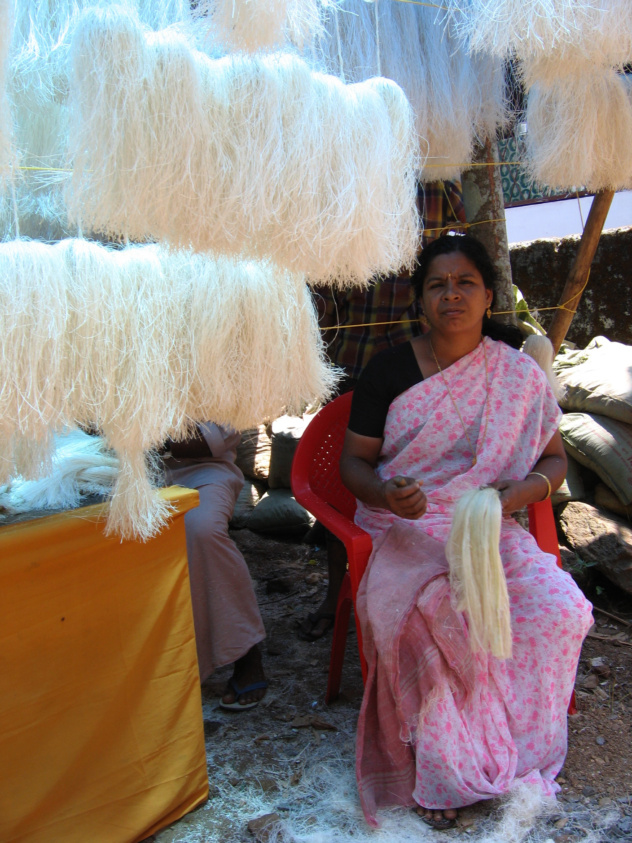払子に似ています。ケララにあるKottiyoorというヒンズー教のお寺のお祭りに一年に一度この『竹の花』を買い家に飾るのだそうです。魔除け的な意味もあるのだろうか。
Tufts of retted bamboo fibers for sale at Kottiyoor Temple in Kerala.Odappu is Bamboo flower.Odappu, a “flower” made of bamboo pieces instantly is a thing every devotee buys from the temple to his home to be hung there for a year.
ふさふさの竹の繊維はリネンの繊維のような柔らかさもある様子で、これであれば折の糸も容易に作れる気がする。今盛んに出回っているバンブーレーヨンは、セルロースを薬品で処理するため様々な問題が起こっているけれど、この『竹の花』の方法で得られるbamboo linenは持続的な抗菌作用もあるだろうし理想的な竹繊維だと思う。

Bamboo rayon
Rayon is a semi-synthetic fiber made by chemically reshaping cellulose. Cellulose extracted from bamboo is suitable for processing into viscose rayon (rayon is also made from cellulose from other sources).Bamboo leaves and the soft, inner pith from the hard bamboo trunk are extracted using a steaming process and then mechanically crushed to extract the cellulose. The cellulose is purified, treated with lye, dissolved (in carbon disulfide), and re-formed to make rayon.
Workers are seriously harmed by the carbon disulfide used to make bamboo viscose. Effects include psychosis, heart attacks, liver damage, and blindness. The CS2 is volatile; rayon workers inhale it, but it is not found in the finished product. Rayon factories rarely give information on their occupational exposure limits and compliance, and legal limits even in developed countries are too lax to avoid harm.
Viscose manufactured from bamboo is promoted as having environmental advantages over viscose made with cellulose extracted from wood pulp. Bamboo crops may be grown on marginal land unsuitable for forestry; although demand for bamboo has sometimes led to felling of forests to plant bamboo, though this has become less common since Chinese forestry policy reforms in the 1990s.The viscose processing results in the same chemical waste products as wood-pulp viscose, notably carbon disulfide, but bamboo cellulose is suitable for a closed-loop viscose process that captures all solvents used.
Mechanically-produced fine bamboo fiber
Tufts of retted bamboo fibers for sale at Kottiyoor Temple in Kerala.Some bamboo fibre is made by a mechanical-bacterial process similar to retting flax into linen fibre.The Swiss company Litrax is one company involved in the manufacturing of bamboo fibre. Litrax claims to use a more natural way of processing the bamboo into fibre. In this the woody part of the bamboo is crushed mechanically before a natural enzyme retting and washing process is used to break down the walls and extract the bamboo fibre. This bast fibre is then spun into yarn. In fine counts the yarn has a silky touch. The same manufacturing process is used to produce linen fabric from flax or hemp. Bamboo fabric made from this process is sometimes called bamboo linen. The natural processing of litrax bamboo allows the fibre to remain strong to produce an extremely high quality product. This process gives a material that is very durable.
Another means of extracting fibre from bamboo, and probably the only purely mechanical process of extraction anywhere in the world, is practiced in the days preceding the annual festival of the Kottiyur Temple of Kerala, India. The handcrafted bamboo artifact, known locally as “odapoovu” is in the form of a tuft of white fibres of up to a foot in length. The article is made out of newly emerging bamboo culms of the reed bamboo endemic to the region (Ochlandra travancorica), which go through a process of alternating pounding with stones and retting in water lasting several days, followed by a combing to remove the pith, leaving the cream white fibres and a stub of the bamboo. The fibre is too coarse and the process very cumbersome, to be of much use in making fine yarn, thread or textiles.